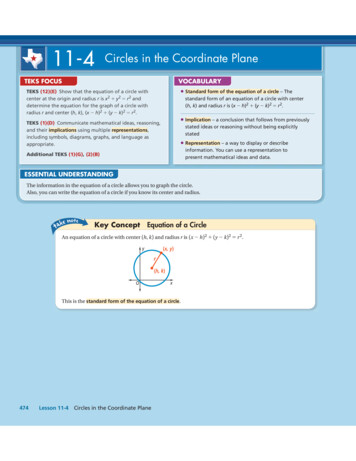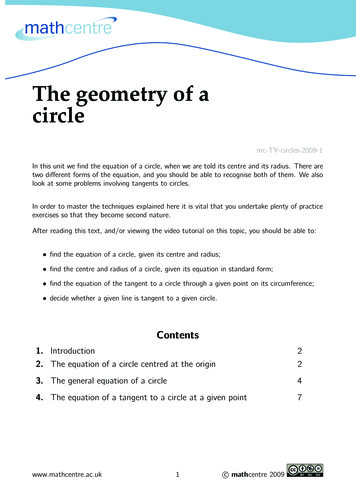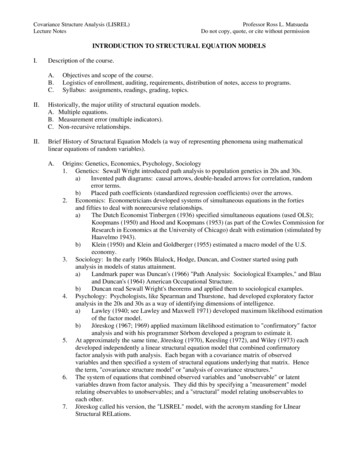
Transcription
Covariance Structure Analysis (LISREL)Lecture NotesProfessor Ross L. MatsuedaDo not copy, quote, or cite without permissionINTRODUCTION TO STRUCTURAL EQUATION MODELSI.Description of the course.A.B.C.Objectives and scope of the course.Logistics of enrollment, auditing, requirements, distribution of notes, access to programs.Syllabus: assignments, readings, grading, topics.II.Historically, the major utility of structural equation models.A. Multiple equations.B. Measurement error (multiple indicators).C. Non-recursive relationships.II.Brief History of Structural Equation Models (a way of representing phenomena using mathematicallinear equations of random variables).A.Origins: Genetics, Economics, Psychology, Sociology1. Genetics: Sewall Wright introduced path analysis to population genetics in 20s and 30s.a)Invented path diagrams: causal arrows, double-headed arrows for correlation, randomerror terms.b)Placed path coefficients (standardized regression coefficients) over the arrows.2. Economics: Econometricians developed systems of simultaneous equations in the fortiesand fifties to deal with nonrecursive relationships.a)The Dutch Economist Tinbergen (1936) specified simultaneous equations (used OLS);Koopmans (1950) and Hood and Koopmans (1953) (as part of the Cowles Commission forResearch in Economics at the University of Chicago) dealt with estimation (stimulated byHaavelmo 1943).b)Klein (1950) and Klein and Goldberger (1955) estimated a macro model of the U.S.economy.3. Sociology: In the early 1960s Blalock, Hodge, Duncan, and Costner started using pathanalysis in models of status attainment.a)Landmark paper was Duncan's (1966) "Path Analysis: Sociological Examples," and Blauand Duncan's (1964) American Occupational Structure.b)Duncan read Sewall Wright's theorems and applied them to sociological examples.4. Psychology: Psychologists, like Spearman and Thurstone, had developed exploratory factoranalysis in the 20s and 30s as a way of identifying dimensions of intelligence.a)Lawley (1940; see Lawley and Maxwell 1971) developed maximum likelihood estimationof the factor model.b)Jöreskog (1967; 1969) applied maximum likelihood estimation to "confirmatory" factoranalysis and with his programmer Sörbom developed a program to estimate it.5. At approximately the same time, Jöreskog (1970), Keesling (1972), and Wiley (1973) eachdeveloped independently a linear structural equation model that combined confirmatoryfactor analysis with path analysis. Each began with a covariance matrix of observedvariables and then specified a system of structural equations underlying that matrix. Hencethe term, "covariance structure model" or "analysis of covariance structures."6. The system of equations that combined observed variables and "unobservable" or latentvariables drawn from factor analysis. They did this by specifying a "measurement" modelrelating observables to unobservables; and a "structural" model relating unobservables toeach other.7. Jöreskog called his version, the "LISREL" model, with the acronym standing for LInearStructural RELations.
Covariance Structure Analysis (LISREL)Lecture NotesB.C.D.III.Professor Ross L. MatsuedaDo not copy, quote, or cite without permissionIn 1970, Karl Jöreskog and his programmer, Dag Sörbom, developed a computer program usingmaximum likelihood to estimate Jöreskog's covariance structure model. They called it the LISRELprogram.1. Uses maximum likelihood estimation for optimal estimates -- this was a watershed in thefield -- integrated path analysis used by sociologists, factor analysis used by sociologists andsimultaneous equations used by econometricians in a unified framework.2. Can deal with measurement models with latent variables and simultaneous equation models.3. The program has been greatly improved over the last three decades; it is now in its eighthversion.Major advances in covariance structure models.1. Browne's (1974) asymptotic distribution-free GLS estimator, based on the generalizedmethods of moments.2. Muthén's (1984) general method for analyzing measurement models with ordinal,categorical, and censored measures.3. Muthén's method for estimating multi-level models (including growth curve models andsome hierarchical linear models) using covariance structure models.A number of new computer programs have appeared—each has some different twist or newfeature.1. Peter Bentler's EQS program uses scalar algebra, first to introduce methods for non-normaldistributions.2. Bengt Muthén's LISCOMP program was the first to introduce methods for analyzing ordinaland categorical variables. His more recent program, Mplus, provides models for ordinal,categorical, growth curve, multi-level data all within a covariance structure framework. Itwill also estimate mixture models for latent class and growth models.3. Stata 12 has Structural equation modeling (SEM) using either graphical commands (likeSIMPLIS) or command syntax in scalar algebra (like EQS), as well as GSEM (GeneralizedStructural Equation Models) and GLAMM (Generalized Linear Latent and Mixed Models).3. R has John Fox’s sem package and Yves Rosseel’s lavann package.4. A few others: Ronald Schoenberg's MILS program in GAUSS; R.P. MacDonald has aprogram; Glymore et al.’s TETRAD program for exploring causal structures; Arbuckle hasAMOS, available through SPSS, SAS has Proc CALIS. There are others as well.Assumptions and Limitations of Linear Structural Equation Models.A.B.C.D.Linear relationships (and usual assumptions of the general linear model).Large samples: for the general case, the estimator -- maximum likelihood -- relies on asymptoticdistribution theory (what happens when the sample approaches infinity) for desireable properties(unbiased and efficient).Interval-level measures.1. Most recent versions of programs can handle categorical and discrete measures - initiallyLISCOMP, now a version is available in LISREL 8 and Mplus.2. These methods are restricted to moderate-sized models and very large samples. Modelscannot deal with discrete latent variables (Mplus can). We'll try to get to them toward theend of the semester.Multivariate normality.1. In general, the estimator and test statistics assume multivariate normal distributions. Somespecific models require that only some observed variables are multinormal (e.g., asimultaneous equation and linear regression models only need assume disturbances aredistributed multinormal).2. LISREL 8 uses weighted least squares (Browne's asymptotically distribution-freegeneralized least squares estimator), which originally appeared in EQS, and also is used inMplus, Amos, etc.
Covariance Structure Analysis (LISREL)Lecture NotesProfessor Ross L. MatsuedaDo not copy, quote, or cite without permission3.E.F.But even this estimator assumes normally-distributed latent variables underlying nonnormally-distributed observed variables. (This is probably reasonable in most applications.)4. Mplus and GLAMM provides a latent class model, which allows for discrete and orderedlatent variables that are not assumed to be normally-distributed.Does not deal with problems of sample selection, nor does it generally deal with violations ofassumptions of the general linear model, like serial correlation and heteroskedasticity (except inspecial situations).Originally ignored sampling weights from large scale complex survey designs, but now Mplus,LISREL 8.8, and Stata SEM can handle sampling weights.IV. General Classes of Models Estimable Using Covariance Structure Analysis.A.B.C.D.E.F.G.H.I.J.K.L.V.A.B.C.D.Single equation linear models (e.g., regression, ANOVA, ANCOVA).Recursive systems of linear equations and path analysis.Seemingly-unrelated regressions.Simultaneous equation (non-recursive) models.Confirmatory factor models (including second-order factor models).Cannonical correlation models.Linear structural equation models with unobserved variables and multiple indicators.Multiple-group models (for modeling interaction effects).Multiple-indicator multiple-cause (MIMIC) models.Models for sibling data and other forms of nested data (certain random effects and fixed effectsmodels); models for datasets with some values missing at random.Models for panel data, including random effects, fixed effects, and autoregressive models.Latent growth curve models and other multi-level structures.Recent Developments.Multi-level models in various forms.1. Models for siblings and other nested data structures with pairs of contexts.2. Latent growth curve models.The use of Markov chain Monte Carlo methods to estimate complex covariance structure models byArminger, Muthén, and others.Mixture models for latent classes and latent classes of trajectories (Muthén; see also Arminger).These models allow for unobserved heterogeneity in the sample, in which different individuals aremembers of different subpopulations, but the subpopulation membership is unknown and must beestimated from the data.1. Latent class model: assign individuals to different latent classes based on binary outcomes.2. Latent growth mixture model: assign individuals to different latent classes based on estimatedtrajectories or growth curves.3. These models depart from the covariance structure framework as they are not estimated from acovariance matrix.Generalized linear models.1. Jöreskog and Sörbom are incorporating into their LISREL program a generalized linear model—a generalization of the linear model, which includes a systematic component (linearrelationship), a random component, and a link function linking the systematic to the randomcomponents. The link function (e.g., identity, log, logit, and reciprocal) has associatedconditional probability distributions (normal, poisson, binomial, and gamma).2. Skrondal and Rabe-Hesketh (2004) have developed a framework, generalized latent variablemodeling, which integrates generalized linear models, latent variable models, multi-levelmodels, and longitudinal models. Their Stata program is GLLAMM (generalized latent andmixed models). Everything above becomes a special case! See also Stata’s GSEM.
Covariance Structure Analysis (LISREL)Lecture NotesE.Professor Ross L. MatsuedaDo not copy, quote, or cite without permissionRecent application of graphical models to causality and structural equations.a. Extension of TETRAD II (Spirites et al. 1993) approach, in which underlying structure isdiscovered through an algorithm that eliminates relationships by identifying causalindependencies. Fragments of causality are put together to create causal models.b. A Bayesian approach is being applied to the graph-based learning methods.c. This material is covered in Judea Pearl’s book Causality.d. Thomas Richardson covers this in his CS&SS course 566, Causal Modeling.EXAMPLES OF SUBSTANTIVE APPLICATIONS OF SEM
Covariance Structure Analysis (LISREL)Lecture NotesProfessor Ross L. MatsuedaDo not copy, quote, or cite without permission
Covariance Structure Analysis (LISREL)Lecture NotesProfessor Ross L. MatsuedaDo not copy, quote, or cite without permission
Covariance Structure Analysis (LISREL)Lecture NotesProfessor Ross L. MatsuedaDo not copy, quote, or cite without permission
Covariance Structure Analysis (LISREL)Lecture NotesProfessor Ross L. MatsuedaDo not copy, quote, or cite without permission
Covariance Structure Analysis (LISREL)Lecture NotesProfessor Ross L. MatsuedaDo not copy, quote, or cite without permission
Covariance Structure Analysis (LISREL)Lecture NotesProfessor Ross L. MatsuedaDo not copy, quote, or cite without permission
Covariance Structure Analysis (LISREL)Lecture NotesProfessor Ross L. MatsuedaDo not copy, quote, or cite without permission
Covariance Structure Analysis (LISREL)Lecture NotesProfessor Ross L. MatsuedaDo not copy, quote, or cite without permission
Covariance Structure Analysis (LISREL)Lecture NotesProfessor Ross L. MatsuedaDo not copy, quote, or cite without permission
Covariance Structure Analysis (LISREL)Lecture NotesProfessor Ross L. MatsuedaDo not copy, quote, or cite without permission
Covariance Structure Analysis (LISREL)Lecture NotesProfessor Ross L. MatsuedaDo not copy, quote, or cite without permission
Covariance Structure Analysis (LISREL)Lecture NotesProfessor Ross L. MatsuedaDo not copy, quote, or cite without permission
Covariance Structure Analysis (LISREL)Lecture NotesProfessor Ross L. MatsuedaDo not copy, quote, or cite without permissionFigure 4. A path model for the resemblance of impulsivity and antisocial
Covariance Structure Analysis (LISREL)Lecture NotesProfessor Ross L. MatsuedaDo not copy, quote, or cite without permission
field -- integrated path analysis used by sociologists, factor analysis used by sociologists and simultaneous equations used by econometricians in a unified framework. 2. Can deal with measurement models with latent variables and simultaneous equation models. 3. The program has been greatly improved over the last three decades; it is now in its .

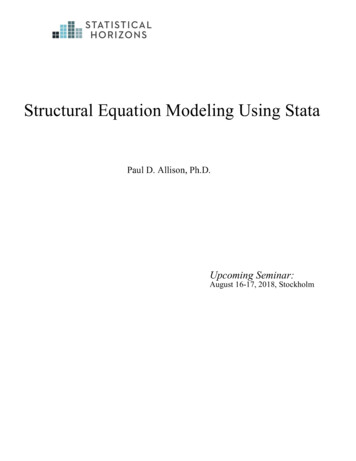
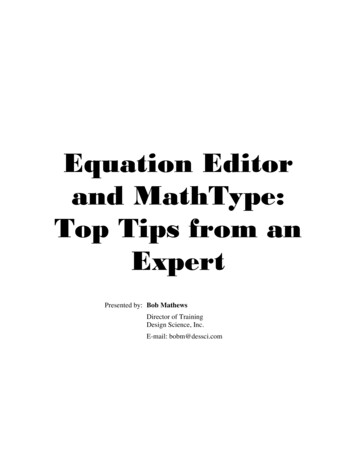
![[SEM] Structural Equation Modeling - Stata](/img/31/sem.jpg)

